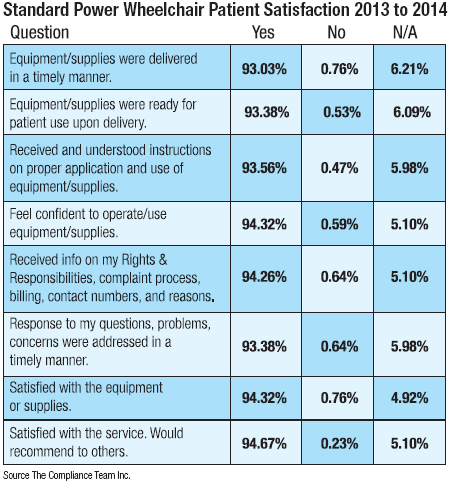State of Satisfaction
The State of Mobility Satisfaction
New data from The Compliance Team helps you benchmark your mobility patient satisfaction against national trends.
- By David Kopf
- Jun 01, 2015
Are your patients happy with the service and equipment you’re providing them? Were they properly set-up? Is it suiting their needs? Are you sure? And above all, how do you know?
Any provider should be able to answer those questions, assuming it has been accredited to bill Medicare on behalf of patients. Medicare accreditation requires that providers document patient satisfaction by way of their accreditation procedures. Providers that don’t track satisfaction can get docked points on their accreditation score.
That said, CMS doesn’t outline specific metrics for collecting patient satisfaction data, or the specific questions providers should ask patients. Instead, CMS leaves it up to its deemed accrediting organizations. The AOs have established standards for how providers should collect patient satisfaction and complaint data from their customers. Then, the AOs issue pass/fail grades regarding each provider’s overall patient satisfaction. So, the various Medicare AOs might differ in their individual standards for patient satisfaction data collection, but the provider must live up to those standards.
But on top of the requirement to track satisfaction, surveying patients and generating that data makes solid business sense, because it can give providers the kind of information they can use to improve their businesses. Providers can use satisfaction data as a tool to sharpen their performance, address problems, and differentiate their services to their referral partners.
Would You Like Some National Data?
Furthermore, beyond just tracking their internal performance, providers can compare it to other providers’ data on a national basis. In fact, you can do that — right now. Since the March issue, HME Business has been working with AO The Compliance Team Inc. to provide national patient satisfaction data to our readers so that they can see out they stack up.
The Compliance Team has all of its providers use the same tool to collect satisfaction data. That tool funnels the patient satisfaction data they collect into a single database, where it is compared against thousands of other providers. The result: a nationwide patient satisfaction benchmarking resource.
“Providers in our database have the capability to benchmark themselves against the thousands of providers in the database,” says TCT Founder and President Sandra Canally, RN.
Best of all, TCT expanded enrollment for its web-based patient satisfaction reporting and benchmarking service last year to include all DMEPOS provider organizations whether accredited by The Compliance Team or by another Medicare-approved accreditation organization. Yep, that’s right, you can compare your performance against the more than 1.3 million patient satisfaction surveys the AO has collected, aggregated and benchmarked. To date, The Compliance Team has garnered 10 million standardized data points from providers based in all 50 states, Puerto Rico and the US Virgin Islands, according to Canally.
This Month’s Data: Standard Power Mobility
In our March issue, HMEB sat down with Canally to examine oxygen patient data. This month, we take a look at standard power mobility. The feedback being examined is from patients with scooters and standard power chairs, not complex rehab chairs. This time around, we’ve grabbed a chunk of data that summarizes their feedback from 2013 to 2014 (our March project covered a much longer date range).

At the outset, it should be clear to the casual observer that nearly all the patients surveyed during that time were satisfied with the services, care and equipment they are getting. But the overall satisfaction is not the important data, what’s important is looking at the other numbers.
And in that case, the big, red flag that should jump out at any observer is the non-applicable (N/A) responses. It should be nearly impossible for a mobility patient to consider any one of the eight questions asked in the chart (above) as non-applicable. How could a wheelchair patient, caregiver or a provider possibly consider questions regarding the patient’s confidence to use the equipment or that the equipment was properly set up non-applicable?
“We’re going to do is start having them clarify why it is N/A,” Canally says. “In terms of ‘equipment and supplies were delivered in a timely manner,’ why would that be an N/A?”
A possibility could be that a caregiver or relative received the item on behalf of the patient, but ambiguous answers amounting to several percentage points of patient satisfaction feedback shouldn’t be acceptable to anyone. Clarification is needed.
And of course, the no answers speak volumes, as well. A provider should want to know how many patients didn’t receive their equipment in a timely manner, or that weren’t satisfied with what they received. Those are incredibly important data points, because the patient’s therapy and health are at stake. The provider needs to make things right, because 95 percent satisfaction doesn’t cut it; the goal is total satisfaction.
This article originally appeared in the June 2015 issue of HME Business.
About the Author
David Kopf is the Publisher HME Business, DME Pharmacy and Mobility Management magazines. He was Executive Editor of HME Business and DME Pharmacy from 2008 to 2023. Follow him on LinkedIn at linkedin.com/in/dkopf/ and on Twitter at @postacutenews.